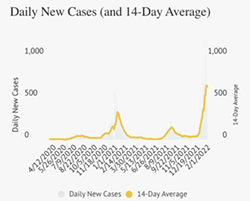In large urban areas like New York City and Los Angeles, COVID-19 cases have already passed their peaks—a respite after omicron brought about the sharpest upswing in cases seen in the pandemic thus far. But in more rural areas like the Central Coast, cases haven't definitively reached the top of the roller coaster just yet.

- Graph Courtesy Of SLO County Public Health Department
- STILL SURGING COVID-19 cases in SLO County aren't showing any signs of letting up just yet as of Feb. 1.
"We hope that we will follow the same trend that we're reading about in the papers from other jurisdictions and seeing in the statistics, but we really don't know if we're continuing to go up, or if we're at the peak now, or if we're going to start seeing a decline," said Michelle Shoresman, SLO County Public Health Department spokesperson.
Throughout November 2021 to early December, SLO County's 14-day average of daily new cases remained flat: around 37 cases, on average. But in mid- to late- December, the metric began a steady increase. Cases exploded after Christmas, nearly quadrupling in the two weeks after the holiday. On Jan. 28, the 14-day average for daily cases hit an all-time pandemic high of 649.
To compare to neighboring counties, case rate data indicates that Santa Barbara County's peak may have already passed: on Jan. 10, the case rate per 100,000 residents peaked at 257.3, and on Jan. 27 it was down to 147. SLO County has only released case rate data up to Jan. 23, which was at 208.5 cases per 100,000—the highest seen in this surge so far.
"We're of course watching the case count in all jurisdictions, and across the state, but I don't know that we've determined that there's any predictive value based on what they are seeing in other places," Shoresman said.
Omicron is the overwhelmingly dominant variant causing infection at this point.
"Earlier in the surge, we were still seeing some delta, but now with the sequencing that we're doing—which is, of course, still just a sample—all of our samples that are being sequenced are coming back omicron," Shoresman said.
She added that the majority of cases continue to be in unvaccinated and unboosted individuals.
"There have been more breakthrough cases than there have been with previous variants, but in comparison, the number of breakthrough cases is still minuscule to the number of cases that we're seeing in unvaccinated and unboosted people," Shoresman said. "You hear anecdotally about the breakthrough cases more often because I think people talk about them more, but they are really small in percentage and numbers in comparison." Δ
Comments